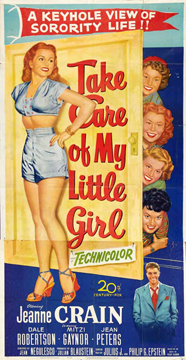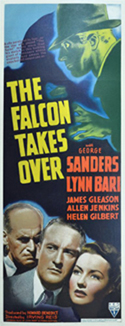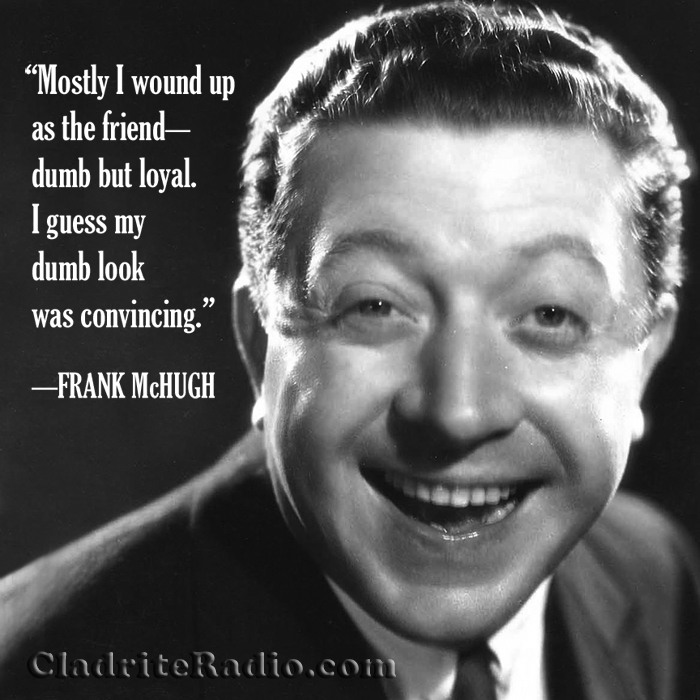Here are 10 things you should know about Robert Armstrong, born 130 years ago today. Best remembered for his association with a certain giant ape, he amassed more than 200 film and TV credits.
Tag: James Gleason
Fame in the Family
A slightly different version of this story was first posted on August 30, 2013…
 It takes something close to a village to make a movie, but it’s only the bigger names that generally get documented. We’re not inclined to ask, “How did Joan Crawford‘s life turn out?” (or Jack Webb‘s or Jimmy Stewart‘s) because, well, we already know.
It takes something close to a village to make a movie, but it’s only the bigger names that generally get documented. We’re not inclined to ask, “How did Joan Crawford‘s life turn out?” (or Jack Webb‘s or Jimmy Stewart‘s) because, well, we already know.
But what about James Gleason (a character actor of the 1930s, ’40s and ’50s) or Pamela Baird (she played Wally’s gal Mary Ellen Rogers on Leave It To Beaver) or Virginia Gregg (she appeared on seemingly every other episode of Dragnet in the ’60s, playing a different character each time)? These workaday actors come and go, and too often we know little to nothing about them.
That’s why we often find ourselves, when watching a movie from the 1930s or ’40s—or a television program from the 1950s or ’60s—turning to imdb.com to follow up on the lives and careers of those actors who made a living playing small parts.
We wondered, in a post we wrote some years back, whether the descendants of people who whose hands appear in old movies—and only their hands (someone got paid, after all, to provide the steady, well-groomed hands that are seen in so many old movies writing letters in close-up)—are as proud of their ancestors’ cinematic contributions as the sons and daughters (and grandsons and granddaughters) of the top stars must surely be.
Similarly, we wonder about those actors who made only the tiniest mark in Hollywood: Do their children (and their children’s children) point with pride to their father’s two lines in a Bowery Boys comedy or their grandmother’s fifteen-second appearance as a diner waitress in a low-budget noir thriller from the early ’50s?
We came across just such a performance last night while watching Take Care of My Little Girl (1951), an exposé of the excesses of the sorority system on college campuses.
We looked up a number of the cute starlets (there are dozens) who play sorority girls and rushees in the picture, but one in particular caught our attention.
Her name was Virginia Hunt, and she played Lyn Hippenstahl, a sorority hopeful who is heartbroken to learn that, after she has endured the humiliations of Rush Week, not a single sorority has extended to her an invitation to join their organization.
Here’s the brief scene in which Virginia appears. In it, dozens of freshman girls wait in line, each awaiting an envelope that contains cards from the sororities that have expressed a willingness to accept her as a member:
Our Ms. Hunt is given exactly four lines in the scene, and her character is crushed with disappointment. Did she wonder at the time why she was chosen for the character who is rejected? “Am I homely?” perhaps she wondered.
We often wonder this about actors who are cast as the plain girl or the dorky guy or someone whose girth is the object of ridicule. Does the thrill of being cast in a movie or television show—and the pay that accompanies it—outweigh the pain of being considered suitable to play such a role? Surely, inside every Plain Jane or Nerdy Norville, there lurks the soul of a leading lady or man, no?
But the most striking aspect of Ms. Hunt’s imdb.com profile is its sparseness. A date of death is offered (April 26, 2007), but no date of birth. And her filmography includes just a single entry: After portraying the under-appreciated Ms. Hippenstahl, it seems our Virginia never worked in the movies again.
Of course, that doesn’t mean she didn’t go on to lead a happy life. She might well have been very successful in another field of endeavor, or perhaps she married a great guy and raised a crop of kids. Or both! Who knows?
But in the movie biz, Virginia’s moment in the sun was less than sixty seconds long. Do those family members who came after her—her children, her nieces and nephews—even know that she appeared in a movie? Have they seen it?
These are the mysteries that intrigue us.
A Frothier, Funnier ‘Farewell, My Lovely’
 As we advised you to do, we recorded the first eleven entries in RKO’s “The Falcon” series of mysteries on TCM the other day, and by last night, we’d worked our way up to watching the third one, The Falcon Takes Over.
As we advised you to do, we recorded the first eleven entries in RKO’s “The Falcon” series of mysteries on TCM the other day, and by last night, we’d worked our way up to watching the third one, The Falcon Takes Over.
The Falcon movies aren’t great, but they have a certain frothy charm, the repartee’s enjoyable enough, and at least some of them feature both Allen Jenkins and James Gleason in supporting roles, and that’s a combination that’s hard to beat.
We were especially looking forward to this picture because it’s based on Raymond Chandler‘s Farewell, My Lovely. In this version, it’s George Sanders as The Falcon, not Philip Marlowe, who solves the crime, but it was fun to see a familiar story played out in a different style, a different city (NYC rather than Los Angeles) and with a different set of characters.
One recognizes the source material right away, as just two minutes in, Moose Malloy has already made an appearance, and his name is…Moose Malloy. And the lost love he’s trying to track down is named Velma.
In fact, the filmmakers didn’t bother to change many of the characters’ names: Jessie Florian, Jules Amthor, Ann Riordan and Laird Burnett are all present and accounted for.
The Falcon Takes Over doesn’t stack up to Murder, My Sweet (1944) or Farewell, My Lovely (1975); it’s an entirely different kind of picture. But it is just smidge darker than the typical Falcon picture, and we found that suited us just fine.
Happy 118th Birthday, Frank McHugh!
Comic relief and sidekick extraordinaire Frank McHugh was born 118 years ago today in Homestead, Pennsylvania. If you’re not sure you recall McHugh’s name, you’ll surely recognize his face if you’ve seen even a few movies from the 1930s and ’40s.
Here are our ten Frank McHugh trivia tidbits:
- Frank McHugh’s parents ran a stock company, and as a child, he occasionally appeared in their productions. He also toured in vaudeville before making his Broadway debut in The Fall Guy in 1925, a play cowritten by George Abbott and character actor James Gleason.
- McHugh, who signed with First National/Warner Brothers as a contract player in 1930, appeared in more than 90 pictures over the next twelve years.
- Frank McHugh made 11 pictures with his pal James Cagney (they were both, along with Pat O’Brien and others, a part of Hollywood’s Irish Mafia).
- McHugh also appeared in 12 pictures with fellow character actor Allen Jenkins.
- Frank McHugh twice reprised in a remake a character he’d already played in the original version of that film: in One Way Passage (1932) and ‘Til We Meet Again (1940), he played a thief eluding Chinese authorities, and in both The Crowd Roars (1932) and Indianapolis Speedway (1939), he played a character named Spud Connors.
- Two of McHugh’s siblings, Matt McHugh and Kitty McHugh, were also film actors. Matt had appearances in more than 220 movies, shorts and TV series to his credit, and Kitty compiled 60 appearances in film and on television.
- Frank McHugh was an eager participant in USO tours during World War II and he was also a member of the Hollywood Victory Caravan, a troupe of 21 stars that traveled the US by train for three weeks, performing along the way to raise money for the Army and Navy Relief Fund.
- McHugh’s USO efforts earned him a citation from the army “for exceptionally meritorious service while working as a member of an entertainment unit” that was signed by Major General Raymond S. McLain.
- Frank McHugh starred in his own radio program, Hotel for Pets, from 1954-56. Some oldtime radio references list the progam as a soap opera, but that somehow seems unlikely to us.
- McHugh and his wife, Dorothy, were married from 1933 until his death in 1981. They had three children together and two grandchildren.
Happy birthday, Mr. McHugh, wherever you may be!

Virginia Hunt, We Hardly Knew Ye
 It takes something close to a village to make a movie, but it’s only the bigger names that generally get documented. We’re not inclined to ask, “How did Joan Crawford‘s life turn out?” (or Jack Webb‘s or Jimmy Stewart‘s) because, well, we already know.
It takes something close to a village to make a movie, but it’s only the bigger names that generally get documented. We’re not inclined to ask, “How did Joan Crawford‘s life turn out?” (or Jack Webb‘s or Jimmy Stewart‘s) because, well, we already know.
But what about James Gleason (a character actor of the 1930s, ’40s and ’50s) or Pamela Baird (she played Wally’s gal Mary Ellen Rogers on Leave It To Beaver) or Virginia Gregg (she appeared on seemingly every other episode of Dragnet in the ’60s, playing a different character each time)? These workaday actors come and go, and too often we know little to nothing about them.
That’s why we often find ourselves, when watching a movie from the 1930s or ’40s—or a television program from the 1950s or ’60s—turning to imdb.com to follow up on the lives and careers of those actors who made a living playing small parts.
We wondered, in a post we wrote some months back, whether the descendants of people who whose hands appear in old movies—and only their hands (someone got paid, after all, to provide the steady, well-groomed hands that are seen in so many old movies writing letters in close-up)—are as proud of their ancestors’ cinematic contributions as the sons and daughters (and grandsons and granddaughters) of the top stars must surely be.
Similarly, we wonder about those actors who made only the tiniest mark in Hollywood: Do their children (and their children’s children) point with pride to their father’s two lines in a Bowery Boys comedy or their grandmother’s fifteen-second appearance as a diner waitress in a low-budget noir thriller from the early ’50s?
We came across just such a performance last night while watching Take Care of My Little Girl (1951), an exposé of the excesses of the sorority system on college campuses.
We looked up a number of the cute starlets (there are dozens) who play sorority girls and rushees in the picture, but one in particular caught our attention.
Her name was Virginia Hunt, and she played Lyn Hippenstahl, a sorority hopeful who is heartbroken to learn that, after she has endured the humiliations of Rush Week, not a single sorority has extended to her an invitation to join their organization.
Here’s the brief scene in which Virginia appears. In it, dozens of freshman girls wait in line, each awaiting an envelope that contains cards from the sororities that have expressed a willingness to accept her as a member:
Our Ms. Hunt is given exactly four lines in the scene, and her character is crushed with disappointment. Did she wonder at the time why she was chosen for the character who is rejected? “Am I homely?” perhaps she wondered.
We often wonder this about actors who are cast as the plain girl or the dorky guy or someone whose girth is the object of ridicule. Does the thrill of being cast in a movie or television show—and the pay that accompanies it—outweigh the pain of being considered suitable to play such a role? Surely, inside every Plain Jane or Nerdy Norville, there lurks the soul of a leading lady or man, no?
But the most striking aspect of Ms. Hunt’s imdb.com profile is it’s sparseness. A date of death is offered (April 26, 2007), but no date of birth. And her filmography includes just a single entry: After portraying the under-appreciated Ms. Hippenstahl, it seems our Virginia never worked in the movies again.
Of course, that doesn’t mean she didn’t go on to lead a happy life. She might well have been very successful in another field of endeavor, or perhaps she married a great guy and raised a crop of kids. Or both! Who knows?
But in the movie biz, Virginia’s moment in the sun was less than sixty seconds long. Do those family members who came after her—her children, her nieces and nephews—even know that she appeared in a movie? Have they seen it?
These are the mysteries that intrigue us.
